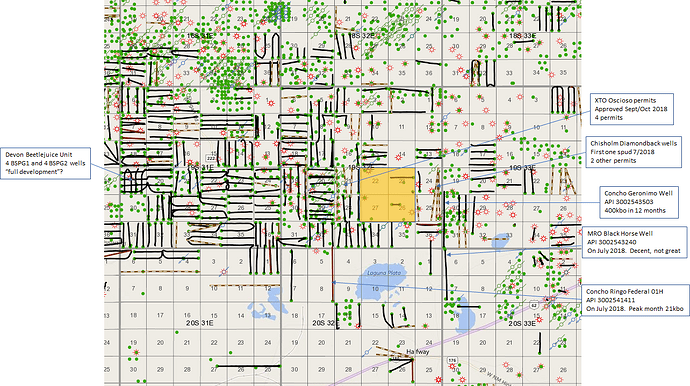Engineer here…a little late to the conversation, but wanted to add this in case others were wondering.
In my experience, these random “blank spots” in development are usually related to the land/lease owner, lease terms, or operator. Rarely that the oil reservoir just “stops” when there’s unconventional horizontal drilling involved (but vertical production…maybe). Everything M_Barnes said about the reservoirs being hard to find is also true, for your question on why we don’t know everything.
(Side note, the map above is an image from NM, probably the north-most edge of the Delaware Basin)
Land/Lease Owner: When I see a patch like this that lines up with the section lines and looks like it could have been a good property line, this is my first thought. I worked an area we were desperate to drill; some of our best reservoir. But a stretch of sections were owned by a certain family who was in conflict. We needed to negotiate a new lease in order to be able to drill (the lease we had wouldn’t allow any more surface locations) and the family was in too much disagreement to come to agree on anything. We tried upping our payment far beyond normal and still no traction, and this was 2014 when oil was $100. We gave up and went on to other easier sections to drill.
Lease terms: Similarly, I’ve also seen it where we skip over a section because the lease has a funny, unfavorable structure vs ones around it. Sometimes landman get creative to get deals done (“you can lease this southwest 1/4 section and develop it, but you have to pay us $500,000 for every well you drill if we decide to not participate and then if the well makes a really good profit then we want back in but with these new terms…yadda yadda”). Sometimes these leases were set up in a much different economic market, which usually you can renegotiate, but at that point, you may be on to better things.
Wells being drilled are (hopefully) economic, but when factors like this start stacking up, it can quickly make a well not worth drilling even if the production is the same section to section.
Operator: Every now and then it’s due to those leases being owned by a different operator than the surrounding developed sections, who isn’t currently focused in that area since they may have better areas to focus on than the operators surrounding that area. Think little tiny company who only owns 20 sections of operated sections, vs a Chevron-sized company that’s busy funneling money into billion-dollar projects offshore.
